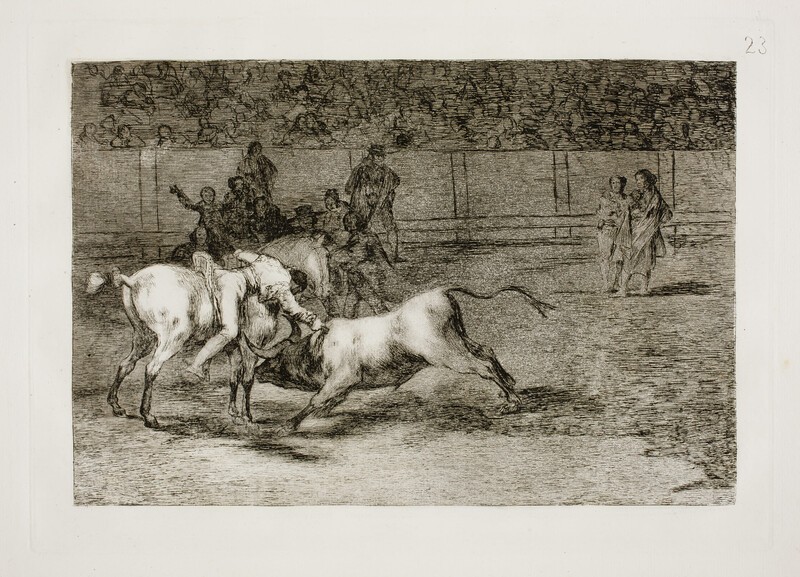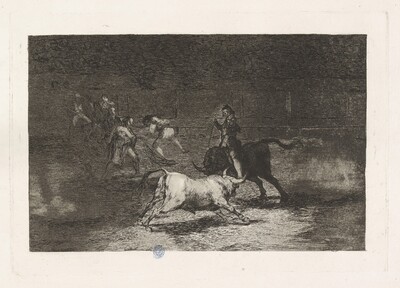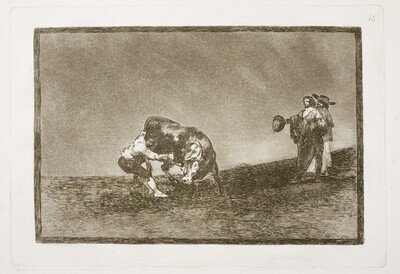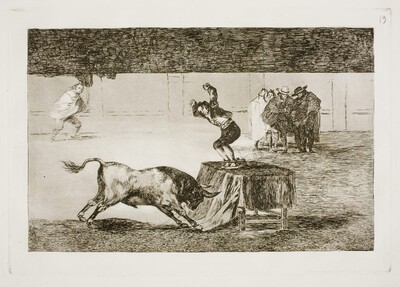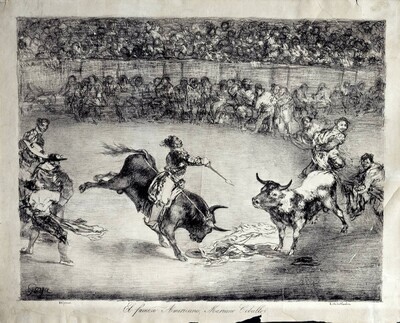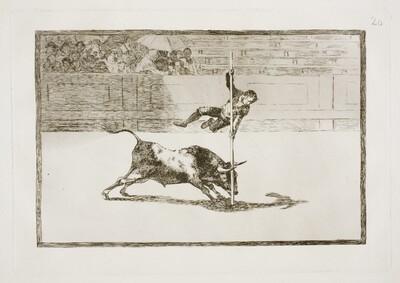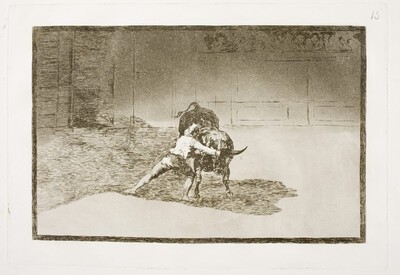- Cronología
- 1814 - 1816
- Dimensiones
- 250 x 350 mm
- Técnica y soporte
- Reconocimiento de la autoría de Goya
- Documented work
- Ficha: realización/revisión
- 02 Oct 2021 / 22 Jun 2023
- Inventario
- -
See How the ancient Spaniards hunted bulls on horseback in the countryside
Four state proofs of this plate are preserved: a first proof without the aquatint, a second proof with the etching and aquatint, another before the aquatint was fully burnished, and the last with the addition of the burnisher to highlight the figure of the bull but before the number was added.
The plate is kept at the National Chalcography (nº 356).
See How the ancient Spaniards hunted bulls on horseback in the countryside.
The first of the three prints dedicated in Bullfighting (nos. 23 and 24) and its extensions (J) to Mariano Ceballos, aka "The Indian", a famous bullfighter from the time of Goya's youth, originally from Spanish America, specifically from the Governorate of the Río de la Plata, part of present-day Argentina.
In the scene we see Ceballos performing his best-known number, which consists of confronting the bull on the back of a horse or another bull. He performs the luck of killing with a short sword, which gives the impression that he is going to fall off the horse. In the bullring we see a large group of people inside the ring, probably members of his crew. The stands are also full of spectators, although we can only guess at them, as we can only see their silhouettes among the stripes that darken the background.
The chiaroscuro effect is particularly notable, especially because only the bull, the horse and Ceballos himself are illuminated, leaving the rest of the elements in semi-darkness.
Beruete highlights Goya's work with the burnisher to achieve the modelling of the bull, especially in reference to the state tests. Sayre also praises the work of the burnisher, who has been removing the lights to give greater prominence to the fight between the bull and Ceballos. Luján, for his part, emphasises the chiaroscuro although he criticises the horse's stagnation, which in his opinion detracts from the dynamism of the whole and does not correspond to the cast depicted.
Lafuente Ferrari believes that Ceballos is carrying a sword or rapier, which he has plunged almost completely into the bull's back, and not a dagger or short sword.
Martínez-Novillo includes the work with the bullfighting prints that deal with particular suertes, namely: The very skilful student from Falces, dressed in a bullfighter's cape, teases the bull with his "quiebros", The famous Martincho putting flags at the break, He himself overturns a bull in the bullring of Madrid, Martincho's recklessness in the Zaragoza bullring, Another of his follies in the same bullring,
Lightness and daring of Juanito Apiñani in Madrid and The same Ceballos mounted on another bull that broke rejones in the bullring of Madrid.
In addition to the three Bullfighting prints and their extensions, Goya dedicated a fourth print to Mariano Ceballos, specifically one of his lithographs from the Bulls of Bordeaux series, entitled The Famous American, Mariano Ceballos.
There is a preparatory drawing of this engraving, also entitled Mariano Ceballos, aka "The Indian", kills the bull from his horse.
23 (print, upper right-hand corner)
-
Grabados y dibujos de Goya en la Biblioteca NacionalBiblioteca NacionalMadrid1946catalogue Elena Páez Ríos
-
Goya en la Biblioteca Nacional. Exposición de grabados y dibujos en el sesquicentenario de su muerteBiblioteca NacionalMadrid1978May - June 1978
-
Grabados de Goya: colección propiedad de la Biblioteca Nacional, que se conserva en su Gabinete deCasa de la Amistad de MoscúMoscow1979exhibition displayed from January 18th to 31st 1979
-
1984
-
Madrid1990
-
Goya grabadorFundación Juan MarchMadrid1994consultant editors Alfonso E. Pérez Sánchez and Julián Gállego, from January 14th to March 20th 1994
-
Goya grabadorMuseo del Grabado Español ContemporáneoMarbella1996from March 8th to May 5th 1996
-
Zaragoza1996
-
Schlaf der Vernunft. Original radierungen von Francisco de GoyaMunich2000
-
Madrid2002
-
Madrid2002
-
Bilbao2012
-
Zaragoza2017
-
MadridBlass S.A.1918p. 134
-
1946pp. 177-216, espec. p. 201
-
BarcelonaTartessos-F. Oliver Branchfelt1946 (reed. 1951)
-
1961pp. 120-127
-
OxfordBruno Cassirer1964vol. II, 1964, p. 339, cat. 226
-
Vie et ouvre de Francisco de GoyaParísOffice du livre1970p. 279, cat. 1196
-
The Changing image: Prints by Francisco GoyaBostonMuseum of Fine Arts1974pp. 232-235, cat. 185-187
-
MilwakeeMilwaukee Art Museum1986pp. 24-25 y 32
-
Goya, toros y torerosMadridMinisterio de Cultura, Comunidad de Madrid1990p. 106, cat. 38
-
MadridCaser-Turner1992p. 34
-
Catálogo de las estampas de Goya en la Biblioteca NacionalMadridMinisterio de Educación y Cultura, Biblioteca Nacional1996cat. 345
-
MadridMuseo Nacional del Prado2001pp. 80-81
-
Goya. In the Norton Simon MuseumPasadenaNorton Simon Museum2016pp. 186-201
